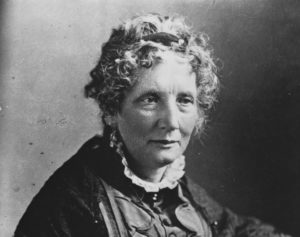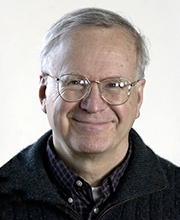Classics Series
David D. Hall on Charles H. Foster’s The Rungless Ladder: Harriet Beecher Stowe and New England Puritanism (Duke University Press, 1954)
The challenge of identifying a work of intellectual history that merits reappraisal led me initially to Perry Miller’s The New England Mind: The Seventeenth Century (1939; 1954) and its sequel, The New England Mind: From Colony to Province (1953). But this, I realized, would mean repeating what I have said elsewhere. Instead, I turn to a virtually unknown book, Foster’s The Rungless Ladder: Harriet Beecher Stowe and New England Puritanism, which I had encountered at the beginning of the 1960s as a graduate student in American Studies at Yale. Much has happened in Stowe scholarship in the ensuing decades, not to mention all that has happened in and around “New England Puritanism.” Nonetheless, The Rungless Ladder remains instructive and, as I realized after returning to it, a book that altered my understanding of religion.
The title stems from a phrase in Stowe’s novel The Minister’s Wooing (1859) and, indirectly, from the story of Jacob’s ladder (Genesis 28). A student of literature, Foster relied on several of Stowe’s novels as his means of mapping her complicated relationship to Puritanism, not the Puritanism of the seventeenth century but the evangelical “Calvinism” of her father Lyman Beecher, the theological framework that also troubled Lyman’s sons. The Rungless Ladder takes for granted the presence of a New England culture that descends from such eighteenth-century theologians as Jonathan Edwards and Samuel Hopkins and remained a significant presence in the mid-nineteenth century, its complexities visible (as Foster points out) in the poetry of Emily Dickinson, the spirituality of Emerson’s aunt Mary Moody Emerson, and the novels that Stowe wrote in the 1850s and 1860s. For Foster, the burdens of this culture come into sharp focus in the particularities of Harriet Beecher Stowe’s response to her father’s counsel, a response shaped and mediated by circumstances that include the death of her mother, the spiritual crisis experienced by her older sister Catherine, and, eventually, the deaths of two of her children.
The most immediate burden of this culture was the ever-troubling question: am I saved? Stowe knew of her older sister Catherine’s crisis of faith in the early 1820s, a crisis provoked by the death of Catherine’s fiancée, the young Yale professor Alexander Fisher, who drowned during his return voyage from Europe in 1822. In letters subsequently included in the “Autobiography of Lyman Beecher” the Beecher children assembled in the  1850s, Catherine asked her father to clarify the spiritual fate of someone who, within the framework of New England Congregationalism, had never formally become a church member. Would God have been merciful as the waves closed over Fisher, or would He have stood by silently, an uncaring observer unable to feel any sympathy for Fisher’s plight? What Lyman said in response made things worse. From that moment on, a wound opened up in Catherine and, by inheritance, in her younger sister, a wound that became one of the sources of post-evangelical Protestant liberalism.
1850s, Catherine asked her father to clarify the spiritual fate of someone who, within the framework of New England Congregationalism, had never formally become a church member. Would God have been merciful as the waves closed over Fisher, or would He have stood by silently, an uncaring observer unable to feel any sympathy for Fisher’s plight? What Lyman said in response made things worse. From that moment on, a wound opened up in Catherine and, by inheritance, in her younger sister, a wound that became one of the sources of post-evangelical Protestant liberalism.
Did Harriet pass over into that liberalism or something akin to it? Relying on The Minister’s Wooing and Oldtown Folks, the former provoked in part by the drowning of her son Henry in 1857 at a moment when, like Fisher before him, he had yet to affirm his faith, Foster dismisses any sharp distinctions of this kind. In these novels as in Uncle Tom’s Cabin, certain characters question or denounce the specter of a remote, uncaring God and affirm the alternative of a maternal, loving, sympathetic Christ. In the same novels, however, Harriet includes characters who exemplify the best of her ancestral tradition—for example, Samuel Hopkins in A Minister’s Wooing. Foster’s point is that the novels themselves refuse to resolve these tensions—or at least refuse to resolve them in any simple matter. Little Eva and Uncle Tom suffer greatly despite their closeness to Christ. In other characters and, especially in the structure of her fictional re-imaginings of a theological tradition, Harriet sustains (as Foster puts it (p. 114) a “complex awareness that she must say both yes and no to the ancestral faith.” In short, her portrait of “puritanism” has “the confused depth of reality.”
Why did this description of Stowe’s religious culture matter to me? For one, it was (and is) sharply different from Miller’s approach and from that of his students—Ann Douglas in particular—who reiterate what he argued. In the opening pages of The New England Mind, Miller frames his story around dichotomies. Calvin (or true Calvinism) is inflexible, “rigid,” “deterministic” and the like. Unable to satisfy themselves with this harsh message, the colonists fashion a sloppier, covenant-centered theology that makes room for human initiative. In the course of the seventeenth and early eighteenth centuries, the compromises of the covenant theology become untenable—indeed, from Miller’s point of view, despicable. Douglas transferred this scheme to the mid-nineteenth-century and to Stowe in particular, who, from Douglas’ perspective, relished the possibility of jettisoning a intellectualized and masculine “Calvinism” and replacing it with a teary, sentimentalized version of religion.
When I set myself the task of exploring “popular” and, subsequently, “lived religion,” the data—textual, biographical, quantitative—led me back to a Foster-like perspective. Ambiguity abounded, as did contradictions in how people behaved. Picking their way among these contradictions, local people seized upon the rite of baptism as a means of sustaining inter-generational continuities. Incorporating children into the covenant was immensely meaningful. Re-reading Foster, I realize that Stowe’s personal history and the blending of marriage, family, abandonment, rupture, and the presence or absence of God//Christ in her novels set in motion my own speculations along these lines. My thinking was nurtured, as well, by an accidental encounter with the phrase “horse-shed Christians” in the autobiography of G. Stanley Hall. This phrase, which arose as a name for the men who, between services on Sundays, gathered around the horse-sheds and gossiped among themselves, made its way into Worlds of Wonder, Days of Judgment: Popular Belief in Seventeenth-Century New England (1989) as a means of expanding the tempos of religious affiliation and commitment. Miller’s stark “Augustinianism” figured in the play of meanings I was describing, but its role was complicated if not contradicted by ritual practice and the structure of devotion—neither of which Miler touched on his corpus—in shaping the substance of religion for so many people, as it still does to this day. Directly and indirectly, therefore, the nuances of The Rungless Ladder freed me from the structure that Miller imposed upon the past.
In retrospect, Foster’s lucid story has other merits. For example, it mirrors the strengths of “American Studies” as this field was coming into being. Foster references “high” writers and low, the serious and the comic; drawing on the work of Walter Blair and Constance Rourke, who were re-discovering the ante-bellum humorists, he writes sympathetically about Stowe’s own versions of the comic. His premise of “culture,” never for him without internal tensions, enables him to borrow passages from Jonathan Edwards that are juxtaposed with others from Emerson, various Beechers, Dickinson, and a sprinkling of contemporary writers such as Frost. Throughout, he wrestles with the figure of Stowe as author, someone who attributed the crucial episodes of Uncle Tom’s Cabin to dream-like moments in her life, but who was also relying upon specific texts and literary models. It was this kind of American Studies that excited me as an undergraduate and, later, as a graduate student, and that informed my teaching over the years.
To put all of this in a different key, I re-emphasize the lesson I learned from The Rungless Ladder. Puritanism was no tidy box of axioms—despite attempts to characterize it in this manner—but a culture that encompassed tensions and choices of several kinds. Seen in this light, Puritanism can be regarded as having multiple echoes and consequences in the course of time. In this regard it is wholly unlike the factor of “slavery” that, in so much recent cultural history, has become an inescapable something that leaves its mark on every corner of American life. Not so long ago, this was how “class” and gender were construed, each of them inescapable and determinative. Paradoxically, we are at a moment when self-invention and improvisation are also being extolled as part of modernity. The limitations of Foster-style American Studies are real, but so are the limitations of a framework that, in an unacknowledged manner, has it both ways: enshrining both freedom and determinism.
David D. H all is the Bartlett Research Professor at Harvard Divinity School. His books include The Faithful Shepherd: A History of the New England Ministry in the Seventeenth Century; Worlds of Wonder, Days of Judgment: Popular Religious Belief in Early New England; Puritans in the New World: A Critical Anthology and, most recently, A Reforming People: Puritanism and the Transformation of Public Life in New England (2011).
all is the Bartlett Research Professor at Harvard Divinity School. His books include The Faithful Shepherd: A History of the New England Ministry in the Seventeenth Century; Worlds of Wonder, Days of Judgment: Popular Religious Belief in Early New England; Puritans in the New World: A Critical Anthology and, most recently, A Reforming People: Puritanism and the Transformation of Public Life in New England (2011).

0